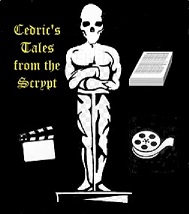











The Ghoul is one of those cases in which imagining something is always better than remembering something. For decades, no print was known to exist. The first British film to be described as "horrific," The Ghoul enjoyed almost mythical status and praise from film students who had never actually seen it. Karloff's role was touted as perhaps his best, and like Lon Chaney's London after Midnight, The Ghoul attained almost Olympian status.
A faded print was found in Czechoslovakia, which was regrettably saddled with Czech subtitles and heavily cut, but it was a start. Then in 1983, a print was discovered that was complete and suitable for restoration. Then people actually saw the film.
Critics agree that The Ghoul isn't the best horror film of the 30s, through no fault of the cast, which included distinguished actors Cedric Hardwicke and Ralph Richardson in their days before knighthood, who struggle to make a good movie from a confusing script.
The Ghoul is based around possession of a rare jewel called the Eternal Light. Everybody wants it for a different reason; as the object of simple greed, as a religious icon, and in the case of Karloff's character Professor Henry Morland as a means to rejuvenation and resurrection from the dead. At least a half dozen characters are after the jewel, and as the script bounces from character to character, it's difficult to see any of them in depth.
The plot is clumsy, relying on a throwaway line near the end about catalepsy a la Poe's "The Premature Burial" to make sense of events. Critic Bryan Senn describes it as a game of "jewel, jewel, who's got the jewel." It also leads us to believe that Morland has died and been resurrected with super strength, bending bars on a window with his bare hands, when his cataleptic condition should have left him in a weakened state.
Jazz saxophonist and movie soundtrack arranger Benny Golson is famous for saying, "The better the script, the less music it needs. The Ghoul proves this rule of thumb. The Film features an original orchestral score by Lewis Levy and Leighton Lucas, unlike many period horror films that used classical music themes that were public domain and were free to use.
The music is well composed. The problem, however, is that it seems to blare almost every second there is no dialog. The audience doesn't need the constant cues to know there is menace, empathy, or levity on the screen. It becomes an annoyance at times rather than an enhancement.
The Ghoul revolves around pairs of characters and their interaction. The principal pairs include Karloff as Professor Morland with Ernest Thesiger as Laing, his servant, reversing the roles the pair played in The Old Dark House with Thesiger as Horace Femm, and Karloff as his brutish servant Morgan. They also shared the screen in Bride of Frankenstein with Karloff as the Monster and Thesiger as the evil Pretorius.
The heirs to the Morland fortune, Betty Harlon, (Dorothy Hyson) and Ralph Morlant (Anthony Bushnell) are the closest thing we see to a hero and heroine, and because they are cousins, the screenwriters didn't need to worry about any romantic interest. Instead, the pair agree to be "partners" in a business sense, sealed with a handshake.
The romantic interest, one-sided as it may be, comes from the pairing of Betty's scatterbrained roommate Kaney and Egyptian jewel thief Aga Ben Dragore who leads Kaney on as he schemes to steal the jewel.
One artful touch is the use of humor side by side with horror as comic relief to ease the tension in the grand tradition of ancient Greek theater and Shakesperean tragedy. Kaney, played by Kathleen Harrison, provides a humorous emotional release valve for the audience, alongside the mounting tension as Morland rises from the dead and moves irrevocably toward another murderous rampage to avenge the theft of the jewel.
The pairing of humor with horror makes The Ghoul far more effective as a result, unlike most of today's horror films which ratchet up tension to the point of shock with little or no release for the viewer.
Having watched The Ghoul from faded prints in the past, I was delighted to see it in its current restored form, a reminder that the old black and white movies were as sharp a screen image the day they were released as any film today.
The restored version highlights the cinematographer's aesthetic, embracing the motifs of German Expressionism popular in the early twentieth century. Gunther Krampf, cinematographer, previously worked on Nosferatu, The Hands of Orlac, and The Student of Prague. The distorted perspectives and crooked staircases of The Cabinet of Doctor Caligari, the stark geometric shadows of Son of Frankenstein, a contrast sharp to the point of harshness, and black silhouettes skulking across the screen present a visual treat to the viewer. The technique makes Karloff's makeup by Heinrich Heitfeldt particularly disturbing.
Seeing the film in its present state with its visual touches offsets much of my reservation about other areas. Despite its faults, The Ghoul is still fun to watch and worth sticking around to the end.
Fright on!
 Click here to return to Cedric's Tales from the Scrypt.
Click here to return to Cedric's Tales from the Scrypt.
 Click here to watch our introductory video.
Click here to watch our introductory video. Click here to access full episodes of the show.
Click here to access full episodes of the show.
 Click here to access the Castle denizens' photo gallery.
Click here to access the Castle denizens' photo gallery.
 Click here to access our personal appearance calendar.
Click here to access our personal appearance calendar.
 Click here to access X-Ray Dead, our house band's Facebook page.
Click here to access X-Ray Dead, our house band's Facebook page.
 Click here to access The Castle Vamporium, our merchandise site.
Click here to access The Castle Vamporium, our merchandise site.